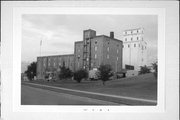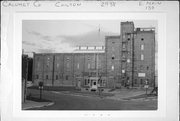Property Record
137 E MAIN ST
Architecture and History Inventory
| Historic Name: | |
|---|---|
| Other Name: | CHILTON MALTING CO |
| Contributing: | |
| Reference Number: | 2938 |
| Location (Address): | 137 E MAIN ST |
|---|---|
| County: | Calumet |
| City: | Chilton |
| Township/Village: | |
| Unincorporated Community: | |
| Town: | |
| Range: | |
| Direction: | |
| Section: | |
| Quarter Section: | |
| Quarter/Quarter Section: |
| Year Built: | 1901 |
|---|---|
| Additions: | |
| Survey Date: | 1977 |
| Historic Use: | industrial bldg/manufacturing facility |
| Architectural Style: | Astylistic Utilitarian Building |
| Structural System: | |
| Wall Material: | Brick |
| Architect: | |
| Other Buildings On Site: | |
| Demolished?: | No |
| Demolished Date: |
| National/State Register Listing Name: | Not listed |
|---|---|
| National Register Listing Date: | |
| State Register Listing Date: |
| Additional Information: | TWO TALL STRUCTURES OF SIMPLE DESIGN. BRICK OFFICE BLDG AND METAL MFG. STRUCTURE TO REAR, ATTACHED? March 2005-This historic complex, begun in 1901, includes the following: -One-story brick office building, with a corbelled stepped parapet (now the technical center) -Brick malt house, 123 feet high with a corbelled cornice and simple pilasters -Galvanized corrugated steel-sided grain elevator, 110 feet high -One-story brick engineer room connecting the malt house and the elevator -Tall, grey concrete structure erected in 1990 -Large unarticulated metal sided structure -Two-story, residential structure Historically, barley was stored in the grain elevator and then in the malt house in large vats of hot water. It sprouted on a concrete floor and then was dried in kilns, heated by coal. Chilton Malting Co. and Briess Industries have two historic roots and two prominent families associated with what is now one company. In Chilton, the Chilton Malting Co. was organized in 1900 by a group of Chilton businessmen. It started in operations in 1902 and ran into immediate financial difficulties. It was then acquired by Frank J. Egerer, a multi-term mayor of the city and entrepreneur, who owned and operated it until his death in 1932, when it passed to the next generation. During Prohibition many companies related to the brewing industry went out of business. The Chilton Malting Co. survived by making malt for no-alcohol beer. In Moravia, Czechoslovakia, Ignatus Briess established a malting company in 1876 It garnered a world-wide reputation for the quality of its malt and extensive international customer accounts. War led the grandson of Ignatus Briess to relocate the company#25;s operations to the eastern U.S. in the 1930s. In the 1950s, the Chilton Malting Co. suffered from a serious lack of accounts while the Briess company needed high quality malt to fill the orders of its accounts. For several decades the Chilton Malting Co. produced the mal while the Briess company handled the sales. In 1978 the Briess company purchased the Chilton Malting Co., thus forming one company. The fourth and fifth generation of the Briess family own and operate the Briess Malt & Ingredients Company, one of the largest privately owned malting companies in the world, a supplier to the majority of the 1,400 or more breweries in the U.S. and a dozen foreign countries. The Chilton Malting Co. is a notable representative of Wisconsin's malting industry. This industry was closely associated with the brewing industry, an important part of Wisconsin's economy and culture. The firm is over 100 years old. An early drawing of the plant shows that several original or early structures remain on the property. The metal structures added to the elevator and engine room do not hide or detract from the original structure, which remains clearly visible, but show the continuation of its historic use as a malting plant. The large, recent additions on the back of the malt house are visible primarily from secondary vantage points from the northeast and east. |
|---|---|
| Bibliographic References: | . |
| Wisconsin Architecture and History Inventory, State Historic Preservation Office, Wisconsin Historical Society, Madison, Wisconsin |


